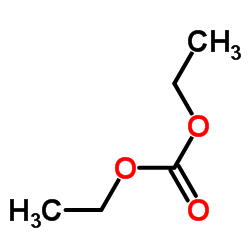Ethyl carbonate

Ethyl carbonate structure
|
Common Name | Ethyl carbonate | ||
|---|---|---|---|---|
| CAS Number | 105-58-8 | Molecular Weight | 118.131 | |
| Density | 1.0±0.1 g/cm3 | Boiling Point | 126.8±0.0 °C at 760 mmHg | |
| Molecular Formula | C5H10O3 | Melting Point | -43 °C | |
| MSDS | Chinese USA | Flash Point | 31.1±0.0 °C | |
| Symbol |


GHS02, GHS07 |
Signal Word | Warning | |
|
Impurity profiling of ibandronate sodium by HPLC-CAD.
J. Pharm. Biomed. Anal. 114 , 254-64, (2015) The modern bisphosphonate drug ibandronate sodium, a challenging candidate for impurity profiling, was analyzed using high performance liquid chromatography (HPLC) combined with corona charged aerosol detection (CAD). Separation was achieved on a mixed mode c... |
|
|
Ultrafine Iron Pyrite (FeS₂) Nanocrystals Improve Sodium-Sulfur and Lithium-Sulfur Conversion Reactions for Efficient Batteries.
ACS Nano 9 , 11156-65, (2015) Nanocrystals with quantum-confined length scales are often considered impractical for metal-ion battery electrodes due to the dominance of solid-electrolyte interphase (SEI) layer effects on the measured storage properties. Here we demonstrate that ultrafine ... |
|
|
Rapid screening of edible oils for phthalates using phase-transfer catalyst-assisted hydrolysis and liquid phase microextraction coupled to high performance liquid chromatography-tandem mass spectrometry.
J. Chromatogr. A. 1420 , 26-34, (2015) Edible oil is easily contaminated with phthalic acid esters (PAEs). Conventional procedures to analyze individual PAEs require very rigorous experimental conditions that are extremely labor-intensive due to significant procedural contaminations generated by t... |
|
|
Effects of Solute-Solvent Hydrogen Bonding on Nonaqueous Electrolyte Structure.
J. Phys. Chem. Lett. 6 , 2888-91, (2015) We investigate the source of Raman background signal commonly misidentified as fluorescence in nonaqueous electrolytes via a variety of spectroscopies (Raman, fluorescence, NMR) and find evidence of hydrogen-bonding interactions. This hydrogen bonding gives r... |
|
|
Room temperature large-scale synthesis of layered frameworks as low-cost 4 V cathode materials for lithium ion batteries.
Sci. Rep. 5 , 16270, (2015) Li-ion batteries (LIBs) are considered as the best available technology to push forward the production of eco-friendly electric vehicles (EVs) and for the efficient utilization of renewable energy sources. Transformation from conventional vehicles to EVs are ... |
|
|
Removal of interstitial H2O in hexacyanometallates for a superior cathode of a sodium-ion battery.
J. Am. Chem. Soc. 137(7) , 2658-64, (2015) Sodium is globally available, which makes a sodium-ion rechargeable battery preferable to a lithium-ion battery for large-scale storage of electrical energy, provided a host cathode for Na can be found that provides the necessary capacity, voltage, and cycle ... |
|
|
Effects of solvents and salt on the thermal stability of lithiated graphite used in lithium ion battery.
J. Hazard. Mater. 167(1-3) , 1209-14, (2009) The thermal stability of lithiated graphite in the presence of solvents, electrolytes and LiPF(6) salt was studied using C80 micro-calorimeter. The presence of cyclic carbonates or linear carbonates increases the activity of Li(x)C(6)-solvent coexisting syste... |
|
|
Hierarchical porous framework of Si-based electrodes for minimal volumetric expansion.
Adv. Mater. 26(21) , 3520-5, (2014) A tunable hierarchical porous framework is fabricated to house the volumetric changes outputted by Si. The nSi@cPAN/cPAN electrodes only expand by 14.3% at full initial lithiation and remain within 23% expansion from its uncycled state after 20 cycles with re... |
|
|
Electrochemical tuning of MoS2 nanoparticles on three-dimensional substrate for efficient hydrogen evolution.
ACS Nano 8(5) , 4940-7, (2014) Molybdenum disulfide (MoS2) with the two-dimensional layered structure has been widely studied as an advanced catalyst for hydrogen evolution reaction (HER). Intercalating guest species into the van der Waals gaps of MoS2 has been demonstrated as an effective... |
|
|
Enzymatic synthesis of fatty acid ethyl esters by utilizing camellia oil soapstocks and diethyl carbonate.
Bioresour. Technol. 102(22) , 10173-9, (2011) This study was reported on a novel process for fatty acid ethyl esters preparation by transesterification and esterification from renewable low-cost feedstock camellia oil soapstocks and friendly acyl acceptor diethyl carbonate. The main components of product... |